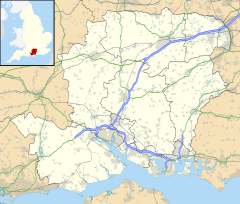Kitwood is a hamlet in the parish of Four Marks, Hampshire, England. It is in the south east of the Parish and has been part of Four Marks since its creation in 1932. Prior to this, it was part of Ropley Parish.
| Kitwood | |
|---|---|
 Road junction in the centre of Kitwood | |
Location within Hampshire | |
| OS grid reference | SU6661633840 |
| Civil parish |
|
| District | |
| Shire county | |
| Region | |
| Country | England |
| Sovereign state | United Kingdom |
| Post town | Alton |
| Postcode district | GU34 |
| Dialling code | 01420 |
| Police | Hampshire and Isle of Wight |
| Fire | Hampshire and Isle of Wight |
| Ambulance | South Central |
Although the settlement was located at the junction of Kitwood road and Swelling, as is visible in older maps, the settlement now spreads all the way from Swelling hill pond to Kitwood farm near Hawthorn Road.

Etymology
editFirst mentioned in AD 1403 as kyteswode [1] meaning the Kite('s) wood from Old English 'cýta' and 'wudu' .[2] The actual woodland that is referred to stood somewhere near to where Kitwood Plantation is nowadays.
History
editThe earliest signs of human activity in Kitwood are a number of mesolithic flint implements that have been found near to the hamlet since the 1950s. Later evidence of Roman activity may also be present nearby as it has been suggested that Swelling Lane, which runs through the hamlet toward Ropley, is the remains of a Roman Road.
Medieval
editArchaeological evidence of activity in around the hamlet can be seen by medieval potsherds found around the area. Since the early 1400s, the is also regularly mentioned in legal documents relating to Ropley. Kitwood Lane is recorded in a court roll record from 1413 [3] as "kitteswodeweye" and during a hedgerow dating survey, commissioned for the Four Marks Village Design Statement,[4] the hedgerow on either side of Kitwood Lane was dated to "approximately 800 years old". This wealth of records suggests significant activity in the area since the 1400s but little evidence of settlement. It is known that since the 13th Century there was settlement near Old Down Wood, northwest of the Hamlet.
Post Medieval
editLong, parallel field boundaries running on a NE-SW alignment are visible north of Kitwood Farm are said to have been laid as a result of the inclosure act of which Ropley was the first parish to be enclosed by act of Parliament, the Ropley Commons (Hampshire) Inclosure and Farnham Park (Surrey and Hampshire) Improvement Act 1709 (8 Ann. c. 16).[5]
Kitwood Farm
editThis farm, not to be confused with the more modern 19th century farmhouse that sits to the east of the main hamlet, was an 18th-century farmhouse that existed from around the early 1700s up to about 1908/9 when it disappeared from maps. The farmhouse stood roughly where Autumn Cottage on Kitwood Lane stands now.
References
edit- ^ https://maps.hants.gov.uk/historicenvironment/herResults.aspx?monuid=39220
- ^ "Old English Dictionary: Find Old English Words | Old-Engli.sh".
- ^ held in the records of Winchester College
- ^ https://cdn.easthants.gov.uk/public/documents/27.%20Four%20Marks%20Village%20Design%20Statement.pdf page 27
- ^ Heal, Chris, Ropley's Legacy, The Ridge Enclosures, 1709 to 1850: Chawton, Farringdon, Medstead, Newton Valence and Ropley and the birth of Four Marks (Chattaway and Spottiswood, Four Marks 2021) ISBN 978-1-9161944-3-4
